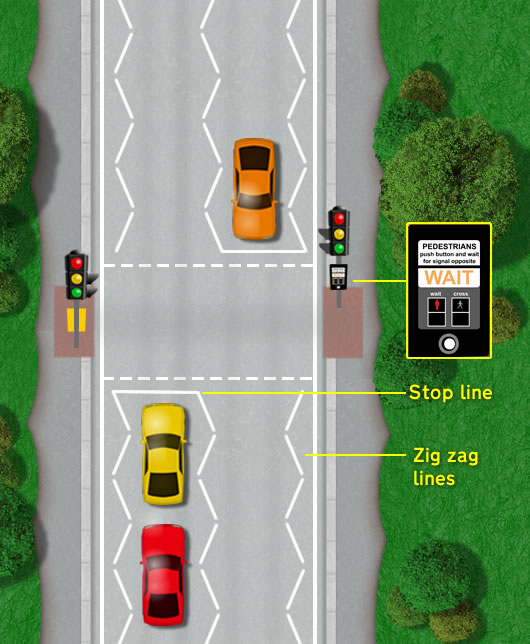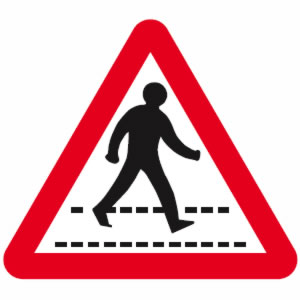The Pelican Crossing was the first successful light controlled replacement for the Zebra Crossing, firsts introduced to the public highway in 1969.
Used on busy town and city roads, it provides a safer means of crossing the road for pedestrians than the rather unpredictable Zebra. During the driving test, the driving test routes will intentionally include many different types of pedestrian crossings, many being the Pelican Crossing.
The driving examiners have strict regulations when it comes to pedestrian crossings and many tests are failed due to these. Understanding the rules not only as a pedestrian, but as a driver is essential if you wish to pass the practical driving test.
Pelican Crossing – Drivers
Whether in general driving or on a driving test, you are likely to encounter many Pelican Crossings. The way in which you approach them has an impact on the overall safety of the pedestrians and other road users. Always looking well ahead whilst driving, keep a keen eye for any signs (see left column) indicating a pedestrian crossing ahead. A sign isn’t always present, so also keep a look out for traffic lights.

Upon locating a Pelican Crossing ahead, initially check your interior mirror to establish if there are any vehicles behind you and is so, how close behind they are. What you see in your mirror may alter the way you approach the crossing. Keep looking up and down the crossing as you approach for any signs of pedestrians or cyclists waiting. If from a distance you can see pedestrians waiting, the chances are that by the time you reach the crossing, the lights will change.
If as you get closer, the lights still have not changed, decrease your speed gently as they are likely to change at any moment. If a car is driving close behind, decrease your speed further to give them sufficient time to stop if necessary. Ensure you do not reduce speed too aggressively as this will be dangerous for vehicles behind you. From a distance, you can also sometimes see the ‘wait’ sign illuminated on the control panel, even more so at night.
If on a driving test, the examiner will be checking your mirror observations and that you are aware there are pedestrians waiting. If you can clearly see that there are no pedestrians or cyclists waiting at the crossing, continue at your normal driving speed.
If the Pelican Crossing lights change and you need to stop, ensure you stop just before the first (closest to you) line (see stop line on diagram). If the Pelican Crossing is on a junction, there may also be a cyclists waiting area. Again, stop at the first line and keep the cyclist area clear.
Stopping in the cyclist box will likely fail a driving test as you should have anticipated the lights changing on your approach to the crossing. On the flashing amber light, ensure the crossing is entirely clear before proceeding.
Pelican Crossing light sequence
Although a Pelican Crossing may tell you to go, many accidents occur due to pedestrians and drivers not checking it is safe before proceeding. When the lights change to either green or flashing amber, check the crossing is clear from pedestrians before proceeding.
| Light sequence for drivers | Light sequence for pedestrians | ||
|---|---|---|---|
| Red light: | Stop | Solid green man: | Cross the road |
| Flashing amber: | Continue if crossing is clear | Flashing green man: | Don't cross as traffic will continue shortly |
| Green light: | Go | Red man: | Don't cross and wait |
| Solid amber: | Prepare to stop |
Pelican Crossing cameras
Stopping directly on a Pelican Crossing is a traffic offence. If the traffic is busy, ensure the car in front clears the crossing and before you proceed, ensure there is sufficient space the other side for you to clear the crossing before entering the crossing area.
Certain Pelican Crossings have cameras fitted that can detect drivers stopping on the crossing area. If you are caught, this can lead to penalty points on a drivers licence (including a provisional) and a fixed fine. Stopping on a Pelican Crossing will of course fail a driving test also.
Failing to stop at red light
This will of course be an immediate driving test failure and happens more than you might think. Again, it is down to the driver to anticipate what is likely to happen at a Pelican Crossing before they get there. If caught by the police or if there is a camera on the crossing, it is highly likely a fine will be imposed and penalty points. The key to driving through all types of pedestrian crossing safely, legally and to pass the driving test is appropriate speed on approach and keen observation.
Pelican Crossing rules
- A solid amber light means the Pelican Crossing lights are about to change red. Solid Amber means slow down and prepare to stop.
- The zigzag lines painted on the road either side of a Pelican Crossing are areas where vehicles are not permitted to park. Parking in these areas obstructs the view of the crossing to other drivers and increases the chances of accidents to both drivers and pedestrians.
- The Pelican Crossing area must be kept clear at all times to allow the safe passage of pedestrians. Stopping in this area is hazardous for pedestrians and will certainly fail a driving test. If the police or cameras are present, a fine and penalty points may be incurred.
- A driver is not permitted to overtake another vehicle on a Pelican Crossing. Overtaking a cyclist is permitted.
- Gesturing pedestrians at a Pelican Crossing to cross should be avoided. A pedestrian may take this action as meaning it is safe to cross and is a common cause of accidents.
- It is an offence not to stop at a red light at a Pelican Crossing.
- A driver is permitted to proceed on a flashing amber providing the crossing is clear of pedestrians.
Pelican Crossing zigzag lines
Zigzag lines are painted either side of the road on Pelican Crossings to mark an area where parking is prohibited. Parking in these areas obscures the view of the crossing for other drivers.
Further information
See zigzag road markings for further information on parking procedures and penalties on yellow or white zigzag road markings.
Pelican Crossing sign

Pelican Crossing road sign
Pelican Crossing road signs may be in place to warn you of a pedestrian crossing ahead. They are however not placed before every crossing. During the driving test, always look well ahead for these signs to give you advance warning.
Pelican Crossing lights
Below is the Pelican crossing light sequence for both drivers and the light sequence for pedestrians at the same time that can be seen on the opposite side of the road.


Pelican Crossing flashing amber
Unlike Puffin Crossings, the Pelican Crossing has a flashing amber light. Drivers are permitted to continue providing the entire crossing is clear of pedestrians.

Will you fail a test if you do not proceed on the flashing amber, if it is all clear, but on the green
If it was all clear and you did not proceed, at worst you would get a minor fault. I think an examiner would have to be excessively harsh to fail you for that and besides, it wouldn’t constitute as a serious or dangerous fault.
Thats what my daughter failed her test on today, I said she should appeal
It can depend on the entirety of the test. If she displayed undue hesitation in other areas, or again at another pelican crossing, this might have been enough for the examiner to fail her. I think if this was the only instance, a minor fault with an explanation at the end would have been more appropriate.
It would be a fail on the driving test as the traffic behind would be held up
Don’t make anyone stop slow down or swerve
The only time you should go through a amber to green is if the crossing is completely clear of anyone wishing to cross.
Zig zag lines you should approach with caution as a driver you have the responsibility.
If a car is approaching from behind and the lights are amber and the vechicle at the line is stationery then they she slow down and prepare to stop if need be.
It doesn’t mean because you have a car coming up from behind you have to get through a amber light that is a fail in a driving test.
Amber meaning a red alert.slow down especially if there is someone waiting to cross common sense tells you the lights are about to turn red.
Red means under no circumstances does a vechicle cross for any reason.
If a car us coming from behind that has to swerve approaching lights then they should have there licence revoked.
In reply to B.B..
Nonsense. You should perhaps learn to drive yourself before advising others!
There’s no instruction to pedestrians on what to do if the green man is flashing. The fact it is green may encourage them to cross and then be caught out when on a fixed timing and if they are not quick enough it turns green to cars before they have completed the crossing. Arguably it would be safer to be a red man given what’s about to happen.
Hi Eyebrowraiser
That would be for the responsibility of road users to correctly assess what’s happening on the Pelican crossing and to wait until it’s clear, regardless of what colour their lights are. This has been particularly highlighted with recent changes to the Highway Code. But I get your point. Perhaps pedestrians can become overly reliant on technology rather than to use their senses to determine whether it’s safe or not.
So I slowly drove over a green light, at a pelican crossing 3/4 through, then the lights went aber/red, not quite through over the pelican lights Guess am guilty?
Hi Mr A Duncan,
It’s the same principle as crossing a lights controlled junction. You’ve committed to the junction, but as you’re crossing, the lights change. You still have to commit and finish crossing, but before attempting to cross the junction, you should ensure that traffic ahead is moving so that you can clear it.
What should you do if pedestrians are waiting at a pelican crossing when there is flashing amber?
Hi Jyoti,
After the red stop light comes the flashing amber. During the flashing amber phase of the Pelican crossing, if pedestrians are waiting but the crossing area is clear, you can continue ahead with caution. You do need to be cautious during the amber flashing phase as some pedestrians may make a last-second dash across the crossing. If you they do, give way.